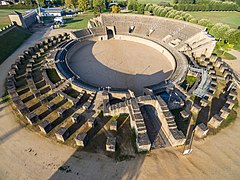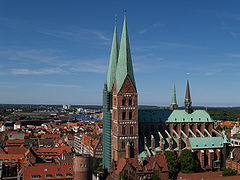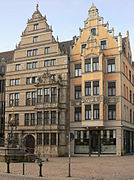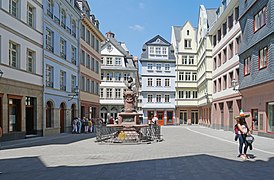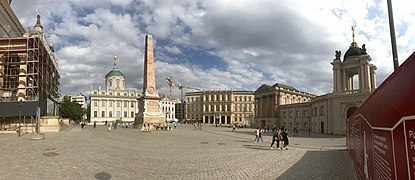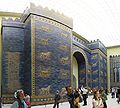Reconstruction (architecture)



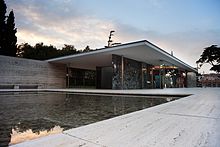
In architecture and monument preservation, reconstruction (sometimes also: reconstruction ) is the largely prototypical restoration of destroyed architectural monuments , historical buildings or parts of buildings . The reconstruction of buildings has been a common practice for centuries.
For the most part, buildings and ensembles that are important in terms of building culture and art history are being reconstructed, mostly after they were destroyed in the war, decay, structural changes (such as demoulding ) or demolition. In the 20th century, the restoration of completely or partially lost buildings was discussed controversially in the course of the global modernism movement , the understanding of monument protection since Georg Dehio and the CIAM Charter of Athens, and sometimes opposing movements such as postmodernism and new urbanism . Many of the reconstructed buildings are now cultural monuments themselves , some even belong to the UNESCO World Heritage List , such as Warsaw's Old Town , Lübeck's Marienkirche , the Bauhaus Dessau and the St. Mark's Tower in Venice . Reconstructions are particularly common in cultural regions that were characterized by war losses and many post-war demolitions of cultural assets, for example in Poland and Germany (see list of reconstructed buildings in Germany ).
When restoring individual parts of an existing building, for example a facade after removal of the stucco , one speaks of partial reconstruction .
In the GDR , which existed from 1949 to 1990 , the term reconstruction in the building industry was often only used for the renewal, refurbishment or modernization of buildings, without any monument preservation intentions or reconstruction plans. This term was also used for a long time in the English-speaking world .
introduction
Reconstructions in the building industry are usually carried out in order to restore landmark buildings and architectural ensembles that have been destroyed by war, political arbitrariness or natural disasters in as identical a form as possible.
The evaluation of reconstruction projects is very different. The reconstruction of the Frauenkirche in Dresden was controversial. The replica of the Mostar bridge has never been in doubt. The restoration of the Twin Towers of the World Trade Center in Manhattan was expressly refrained from.
Types of reconstructions


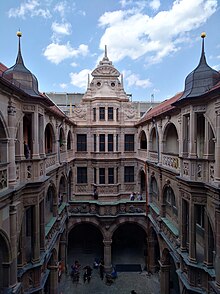
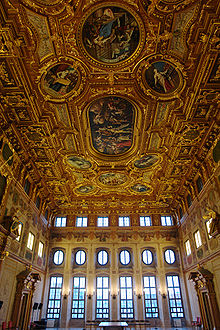





There are different approaches to reconstruction, which differ in the degree of fidelity to the original and in the sensitivity to implementation. In architecture, Georg Mörsch describes reconstruction as a "scientific method of extracting sources to recreate things that have gone under, regardless of the time that has passed since then".
- A true-to-original reconstruction of the building is carried out after extensive source research using the same materials and the same methods as possible. Often existing original components areused. This type of reconstruction is mainly found in culturally and historically significant buildings, which then serve as objects for viewing and are used as museums. An early example is the reconstruction of the transept, crossing and choir of the Altenberg Abbey in the middle of the 19th century, where a collapsed building was rebuilt; Whencompleting the cathedrals, such as Cologne Cathedral , the construction plans that were preserved, but never completed, were followed. The East Prussian Marienburg (Ordensburg) was rebuilt twice, from 1896 to 1918 under restoration of medieval substance andpartly reconstructedafter the 60% destruction in the Second World War . During the Anastilosis , a historical building is rebuilt using its original, but decayed components, which are provided with a new supporting structure.
- A modeled reconstruction is called a reconstruction that does not meet the requirements for fidelity to the original due to a lack of sources. Typical examples are, for example, when only facade plans or image documentation of buildings are preserved - the rest of the necessary information is "reinvented" as much as possible by comparing it with similar contemporary objects. This type of "new creative" reconstruction, combined with a lot of imagination, had its heyday especially in historicism (with neo-Romanesque , neo-Gothic , neo-renaissance and neo-baroque ). B. neo-Gothic castles were created from the remains of medieval castles, such as Hohenschwangau Castle until 1837 by Domenico Quaglio , Lichtenstein Castle (Württemberg) from 1840 according to plans by Carl Alexander Heideloff , Stolzenfels Castle until 1842 by Schinkel and Stüler , Hohenzollern Castle (1850– 1867 by Stüler), the Reichsburg Cochem 1870–1890 by Hermann Ende and Julius Carl Raschdorff or the numerous reconstructions of castles by Bodo Ebhardt in the first third of the 20th century. Theydifferfrom completely new buildings such as Neuschwanstein or Marienburg Castle in the fact that they include existing foundation walls and upstanding components, the fact that they partially comply with historical floor plans and are based on older illustrations.
- Replicative reconstruction is called a reconstruction which, for functionalist reasons, serves to imitate (not: interpret), preserve or produce a (historicized) bill, mostly with a different use. (Example: Nikolaiviertel in BerlinbuiltinGDR times) It no longer has anything to do with the original or old building. Their roots can be found in the new urbanism . His goal is to build places that “enrich life and inspire the spirit”, whereby he is not concerned with representative buildings, but with residential and everyday buildings.
- Interpretive reconstruction creates a new design based on historical sources. Buildings or parts of buildings are created that correspond to the character and overall impression of the original, without attempting a one-to-one copy. Examples are the Prinzipalmarkt in Münster or the additions to the Frankfurt Römer . The façades and gables of the houses were partly redesigned, but the overall impression of the market was to be preserved. This method is derived from the neutral retouching of modern restoration. The missing parts of the original should be overlooked as much as possible at first glance, but the eye looking for them should immediately be noticed as supplemented. This fulfills the requirement of restoring the overall impression without raising the suspicion of the replica (considered to be an impermissible forgery).
- Didactic reconstructions : In connection with the development of archaeological excavation sites into didactic theme parks , reconstructions of striking ancient structures such as city walls, city gates, temples, villas or forts (e.g. on the Upper German-Raetian Limes ), Germanic settlements such as the sacrificial moor have become more and more frequent Niederdorla or medieval fortifications such as the Bach knights castle Kanzach , the tower hill castle Lütjenburg , the Slavic castle Raddusch , the Slavic village Groß Raden , the Stone Age village Kussow , the Ukranenland or settlements like the Bajuwarenhof Kirchheim .
- Experimental replicas are part of the experimental archeology . A knight's castle has been builtin Guédelon since 1997 using only the techniques and materials of the 13th century in order to research the construction method and duration. In Meßkirch , the Galli campus is a project for the construction of a medieval monastery town based on the St. Gallen monastery plan . These are previously non-existent buildings, the focus is on the research aspect.
- Types of reconstructions
Didactic: amphitheater in the Xanten Archaeological Park
True to the original: Ordensburg Marienburg
True to the original: St. Mary's Church in Lübeck
Modeled on: Hohenzollern Castle
Interpretive: market square in Freudenstadt
Interpretive: Prinzipalmarkt in Münster
Replicative: Nikolaiviertel in Berlin
Replicative: Leibniz House in Hanover
Mixed: Dom-Römer-Viertel in Frankfurt am Main
Mixed: Old Market in Potsdam
In Dresden's inner old town , the various reconstruction methods were used in a mixed manner: In the post-war decades , individual buildings whose ruins had survived were rebuilt under the direction of the preservationist Hans Nadler , and several others were saved in their ruinous state. After the turning point and the peaceful revolution in the GDR and German reunification , not only individual buildings, above all the Frauenkirche and the Dresden Residenzschloss , were reconstructed, but also entire squares and streets based on the Warsaw model, such as Neumarkt , Rampische Strasse and Landhausstrasse . Individual facades were true to the original, others were recreated, replicative or interpretive.
But even if a building is rebuilt largely true to the original: in terms of building law, a reconstruction is tantamount to a new building and is therefore generally not a monument in the sense of monument protection . Reconstructions can still be included in the monument protection and even designated as outstanding architectural monuments, such as the buildings in Warsaw's old town , which have been a UNESCO World Heritage Site since 1980 , or the rebuilt Würzburg Residence , which was added to the World Heritage List in 1981 .
Reconstruction challenges
Regardless of what type of reconstruction is done, there are some recurring challenges and questions.
- The original structures were often only incompletely documented, so the missing parts have to be re-thought.
- The building materials or construction techniques that were used to build the original are barely or not at all available or not financially affordable. The same applies to craftsmen who still (or again) master the historical techniques and materials.
- The original would not correspond to the space requirements that the new use of the building will make. The inside of the building will be restructured and subdivided.
- The replica would not meet today's static safety requirements , so you have to change the structure.
- The original or replica with the same interior structure would not comply with the statutory safety regulations , such as in fire protection or escape routes.
- The original or replica would not meet today's legal requirements, e.g. B. According to the Energy Saving Ordinance or according to accessibility .
- If implemented exactly, the original would no longer meet today's comfort requirements (air conditioning, electrical engineering, sanitary installations), so the original design is adapted accordingly.
However, the legal challenges mainly apply to original architectural monuments , as these cannot be re-planned and the modifications have to be carried out in the existing building. The monument protection laws, however, mostly grant freedom with regard to the regulations, so that a largely true-to-original preservation of old buildings is made possible.
Reasons for and against reconstructions
Since the end of the Second World War , the reconstruction of buildings has been the subject of controversy, especially in cities destroyed by the war.
In the public debate it is mostly assumed that historical or historicizing architecture is perceived by the average citizen as more appealing than contemporary architecture . The loss of the "beautiful old" is seen as an aesthetic diminution, historically created and poorly closed building gaps are experienced as a permanent "flaw in the cityscape".
This is evidenced, among other things, by the course of discussions on objects such as the bone carving office in Hildesheim, which was built as a replacement for a post-war modernist building that was perceived as inappropriate. However, the construction of this building was exceptionally true to the original: Instead of the usual reinforced concrete with a curtain wall, the reconstruction was built in a traditional way as a half-timbered house using wooden nails . In the Dresden Coselpalais, however, which was reconstructed from 1998 to 2000, the historic inner courtyard was even dispensed with; instead of restoring the courtyard that was structurally required for lighting and ventilation, artificially lighted floors were created to increase the gross floor area.
The decade-long sterile and unimaginative repetition of the originally pioneering and imaginative design language of modern architecture , spread around the world, is likely to have its share in the distrust of contemporary solutions as well as the tendency of postmodern architecture to be gimmicky.
The publicist Philipp Maaß sees the reconstruction as an “ emancipation of citizenship in architecture and urban planning”. In this context, he calls for “a real architectural pluralism like at the beginning of the 20th century not only to be allowed but also to be promoted”.
The reconstruction of buildings is often controversial among architects and preservationists . There are different motives and values. Overall, the question of the reconstruction of prominent urban locations in the context of the cityscape proves to be significantly more conflictual than is the case with remote buildings or in the open, for example in experimental or didactic reconstructions.
A number of current reconstructions, such as the Neumarkt in Dresden , the Braunschweig Palace , the Berlin City Palace or the Henschelhaus on Königsplatz in Kassel , are new buildings with a historical facade design, but modern construction technology and with completely new uses . The original building fabric is often hardly preserved in the projects mentioned. Architects in particular argue against this approach that it merely creates a historical impression in order to appeal to certain groups of buyers.
However, there are also prominent examples of reconstructions with missing original substance. The reconstruction of completely destroyed Warsaw's Old Town is a reconstruction even in the UNESCO list of World Heritage out. Reconstructed buildings are generally not perceived as such by those who are unfamiliar with the area, which makes the cityscape more attractive in the eyes of the beholder. Even in the awareness of the residents, the fact of the reconstruction of a building is mostly forgotten after a while, the buildings are perceived again as an organic part of their environment. In the general reception of building history, destruction and subsequent reconstruction are nothing more than an episode in the history of the building, which in a certain way differs little from a general renovation. The desire for the original substance, which is usually put forward by monument conservationists, cannot be met in many old buildings either; one speaks of the Theseus paradox .
In official monument preservation , since the publications by Georg Dehio and Alois Riegl , the opinion has often prevailed that destruction must be accepted as an authentic part of the history of a building. This attitude is directed against the extensive "improvement projects" in the era of historicism , which often sought to restore an ideal historical state in reconstructions. Destruction, alterations and extensions are irreversible facts in the history of architectural monuments, which would become illegible through an ideal reconstruction. On the other hand, proponents of reconstruction assert that certain destroyed buildings were of such outstanding importance in terms of art history and of such high design quality that even decades after their disappearance, there may be a legitimate interest in reconstructing them. This also in the sense of the recovery of building culture and the "gentle healing" of z. B. war-torn cities. In addition, a restoration in the sense of historical documentation can be significant as a museum-educational measure. In this context, there is also the desire to show the original movable pieces of equipment that have been preserved, such as furniture, paintings, sculptures, etc., in the reconstructed room that they once belonged to, instead of just presenting them in the neutral environment of a museum or in one Keep magazine inaccessible to the public.
Spolia of the architecture itself, recovered after the demolition or after the destruction, can also serve as an argument for a reconstruction; by inserting it into the reconstructed building, its original effect can be experienced again, but often it is not (excessive damage, risk of weathering, etc.) possible. Cases like the Dresden Frauenkirche, in which every stone that was preserved and recovered from the rubble was reinstalled at its original location, are rare exceptions due to the great technical and financial outlay.
A crucial question in monument protection today is that of the original substance . This does not just refer to the material erected at the time of construction, but also to the various later layers that are evidence of their times. In the preservation of historical monuments, these layers, together with the substance of the building period, are considered to be of value if they are of value according to an art-historical assessment. The practice of both architectural and art history goes so far as not to regard a certain version of an object as “the original”, neither the first version nor the most magnificent or most popular at the time, nor the last one that has been remembered. If an object were to be traced back to an earlier state, there would be no justification for deciding which one. Compared with this special conception of substance, a reconstruction never has the historical complexity and also not the history of the original. With the reconstruction of a certain historical (ideal) condition, the authenticity of a possibly damaged monument or ruin is inevitably lost. A modeled new building never corresponds to its model due to changed materials and construction techniques, even with the best faithfulness to the original. As a historical document, what was destroyed is lost in any case and its replacement constitutes a new document.
Loss of architectural heritage is seen by many citizens primarily as a loss of quality of life; and some buildings are assigned an ideal meaning that goes beyond the pure substance. Certain, lost buildings are perceived as defining the identity of a place, the residents identify these buildings as an indispensable part of their city. On the other hand, architects and preservationists generally object that a reconstructed building always has the aspect of a backdrop architecture and never again achieves the cultural and ideal value of the original - an aspect of "honesty" that is perceived as secondary by those in favor of reconstruction. Opponents of reconstruction also often point out that rebuilding could contribute to the transfiguration of the past. In any case, outstanding buildings usually have a high symbolic character . Their destruction increases this symbolic content. How this is transferred to a reconstruction is difficult to predict.
Reconstruction critics from the architectural profession and related professions start from the idea that modern urban design and contemporary architecture are an expression of social identity that is continuously developing. According to this, it is important for a society to maintain its architecture, which meets its living conditions and needs and whose expression it is, through building projects, and not, however, to recreate old architecture. This consensus as to what is contemporary is being questioned by those in favor of reconstruction. From a cultural-historical point of view, the critics see reconstruction as a phenomenon of the 19th and 20th centuries that had hardly any models in history and is now outdated. Reconstruction can thus only be historically legitimized to a limited extent. On the other hand, the term cityscape - as an architectural unit that goes beyond the individual building - only came into the focus of architecture in the course of modernity. Proponents of the reconstruction, on the other hand, have little fear of contact with the harmonistic architectural conceptions of the 19th century and also point to the lasting popularity of the domes that were “then completed” according to the principles that are not permitted today. However, it is precisely the free access to the formal language of all earlier epochs that is seen as one of the characteristics of historicism as well as postmodernism . In a different sense, the reconstruction fulfills the demand for an answer to the needs of the time and in this sense is an expression of contemporary building activity. How later historical epochs will judge the contemporary phase of architecture and its peculiarities cannot be said.
For architects it is often not desirable to create replicas instead of creating something new. In this sense, every new building is "more historically accurate" because the destroyed objects were an expression of their own time. On the one hand, the “idea of a building” is the actual work of an architect and a reconstruction would represent an appreciation in this sense. On the other hand, every architect works in some way with the history of the building site. This reference to the previous buildings is to be seen as an appreciation, even if it is in explicit contrast. Building solutions by the architects of the historical compete with a new project. The fundamental question that remains is why something should be created again instead of a new building.
Prominent individual examples of reconstruction projects and executions show that architecture is a factor in the public that can still polarize today as it is known from the history of architecture of all times. From a global perspective, the entire discussion about the pros and cons of reconstruction is a problem rooted in Eurocentric sensitivities. Other cultures, both the Anglo-American region and Asia, deal with the topic differently: the regular, complete rebuilding of a Buddhist temple is part of the centuries-old tradition in Asian architecture, the European concept of "true to the original" plays in this cultural area, which has everything at its core Material regarded as worthless shell, still a subordinate role today. The 2000 year old Ise-jingū shrines in Japan are ritually rebuilt every 20 years according to exactly the same plans made of wood. In China, for example, while entire historic cities and city centers are being sacrificed to major urban and economic planning projects ( Shanghai , 3 Gorges Dam ), conversely, historicizing projects are also being implemented - such as the old town project of Datong, a city in the Ming style, or the restoration of the one in the cultural revolution destroyed sacred buildings. In the USA, too, the monument concept plays only a subordinate role today and relates much more to historic monuments that are significant in terms of time and culture than to those of architectural history.
Acceptance of reconstructions
In a representative survey by the Forsa Institute on behalf of the Federal Building Culture Foundation , 80% of all participants were in favor of the reconstruction of historical buildings and 15% were against. Approval for reconstructions was particularly high among women (83%) and 18 to 29 year olds (86%). When asked whether historical buildings should also be rebuilt for other uses, 80% of all participants answered with “yes” and 16% with “no”.
Examples of reconstructions
Completed reconstructions at the place of origin
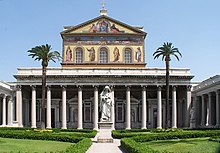




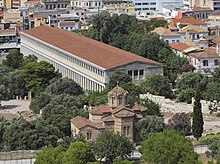


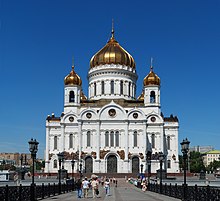
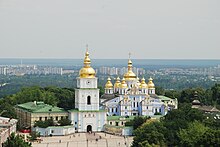
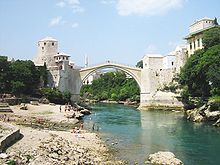
Prominent examples with worldwide attention that illuminate the diversity of reconstructive intentions and methods:
- Before 1945
- Papal Basilica of St. Paul Outside the Walls in Rome: destroyed in a fire in 1823, rebuilt true to the original by 1840
- Markus Tower in Venice: The largely true-to-original copy of the building, which collapsed in 1902, was a trend-setting project for the beginning of the 20th century - the late Wilhelminian era was still completely entangled in the idea of a complete urban redesign with the welcome removal of all outdated structures.
- Cloth hall in Ypres: destroyed in 1918, reconstructed until 1967, UNESCO World Heritage since 1999
- Stonehenge in southern England: Megalithic constructions that were largely preserved in the 16th century, most of which were overturned by the 19th century, were re-erected by William Gowland around 1900. Because the complex is alsointerestingfrom an astro-chronological point of view, the loss of the originallocationcaused by the reconstruction is painful.
- Alcázar of Toledo : The fortress, which was destroyed in the Spanish Civil War 1936–39, was subsequently rebuilt largely true to the original.
- Flagellation Chapel in Jerusalem: In1838,Duke Max Joseph in Bavaria financed the purchase of the long-dilapidated chapel by the Custody of the Holy Land and its restoration for worship. 1927–1929, the building, which still exists today, was built in the style of the Middle Ages under the architect Antonio Barluzzi.
- Governor's Palace in Williamsburg, Virginia: The governor's palace , which was destroyed by fire in 1781, was rebuilt in 1927–1934 from the point of view of completing the tourist-museum cityscape of Colonial Williamsburg according to old models.
- After 1945
- In Europe
- Warsaw Old Town and Royal Castle : The reconstruction of Warsaw's old town and the Royal Castle , which was mainly carried out between 1946 and 1953, were recognized as a “masterpiece”. Today it is recognized as a World Heritage Site by UNESCO. The old towns of Wroclaw , Poznan and Danzig were partially rebuilt.
- Chamber of Commons in Westminster Palace in London: destroyed in a German air raid in 1941, reconstructed 1945–1950
- Forum Fridericianum and Gendarmenmarkt in Berlin: The war-torn building ensembles in the historical center were reconstructed in GDR times.
- Montecassino Monastery in Italy: Destroyed by Allied bombing raids on February 15, 1944, as Wehrmacht soldiers were suspected in the monastery - the art treasures had previously been brought to safety in the Vatican. The monastery was then rebuilt within 10 years according to old construction plans and shows its original appearance in the remote image and in detail.
- Temple of Garni in Armenia: The Greco-Roman temple in Armenia was looted in 1386. In 1679 it was destroyed by an earthquake. Most of the original structure remained in place until the 20th century, which made it possible to rebuild the building between 1969 and 1975.
- Amber room near Saint Petersburg: recreation of the original, which was completely lost in the Second World War, based on old photos from 1976–2003 in the Catherine Palace, the production method and overall appearance high, the details questionable.
- In the successor states of the Soviet Union , many churches and other buildings that were destroyed during Stalinism have recently been restored, including the Cathedral of Christ the Savior , Kazan Cathedral and the Gate of Resurrection in Moscow, St. Michael's Monastery in Kiev and the Transfiguration Cathedral in Odessa.
- Old bridge in Mostar: parts of the fragments that fell into the river were recovered from it. The reconstruction does not use this at all except for the cobblestone cover. For the new building from 1995 to 2004, stone from the historic quarry was used. The manufacturing process of the building was also based on the Ottoman construction technology of the time, for example the use of steel dowels and staples, which are cast around with lead to protect against rust after assembly. The project was funded by the World Bank and promoted by UNESCO through the establishment of an international commission of experts headed by the French archaeologist Léon Pressouyre. It was added to the UNESCO World Heritage List in July 2005, one year after its rededication in summer 2004.
- Frauenkirche in Dresden: The church, which was destroyed in the Second World War and left as a ruin until the fall of the Wall, was reconstructed from 1994, and in 2005 it was ceremoniously rededicated. A special case, because the existing remains of the original building (lower church, the stump of the wall behind the altar and an opposite stump) were included, but the new building with a mosaic-like integration of individual statically still stable parts and u. a. built using historical craft methods. At the same time, the reconstruction of the surrounding Neumarkt began . Other buildings in Dresden's old town that were restored after 1945 are the Residenzschloss , the Hofkirche , the Zwinger , the picture gallery and the Semperoper .
- Teatro La Fenice in Venice : After a fire, the theater was reconstructed in 1996-2003. This building project is of particular interest because of the legendary room acoustics of the old La Fenice. In addition to the purely structural and decorative reconstruction, the acoustics here primarily had to be reconstructed.
- Newgrange in Ireland: Reconstruction of a burial mound from the Stone and Bronze Ages up to 1975, gives an interpretation of the archaeological findings of the original system, the excavation area is a World Heritage Site
- Papal basilica of St. Francis of Assisi in Italy: Reconstruction of the main nave, badly damaged by the 1997 earthquake, with frescoes by Cimabue and Giotto (the “Assisi Puzzle”). Partly only fingernail-sized frescoes were fixed in their original position on a modern, newly constructed supporting vault. About 60–70% of the room decoration has been preserved.
- House of the Blackheads in Riga: burned out in a German air raid in 1941, demolished under Soviet rule in 1948, faithfully reconstructed from 1996–1999
- Grand Princely Palace in Vilnius: former residence of the Grand Dukes of Lithuania , demolished in 1801, reconstructed true to the original in 2002–2018
- Potsdam City Palace : Facadesreconstructedfrom 2010 to 2013 instead of a street intersection from the post-war period as the Brandenburg State Parliament .
- Dom-Römer-Viertel in Frankfurt am Main: By 2018, the city had ten historic buildings that were destroyed in the air raids on Frankfurt am Main in World War IIreconstructedon the site of the former Technical City Hall . These include the Goldene Waage , the Rote Haus , the Junge Esslinger , the Goldene Lämmchen, the Alter Esslinger, the Klein Nürnberg and the Zum Rebstock houses .
- In Asia
- The Tiananmen Gate in Beijing, dating from 1420, was demolished under strict secrecy in 1969 and reconstructed until 1970.
- The Gwanghwamun Gate in Seoul from 1395 was dismantled under Japanese rule and reconstructed in its original location until 2010.
- The "gold temple" Kinkaku-ji in Kyoto, which was destroyed by fire in 1950 , was rebuilt in the tradition of Buddhist architecture
- Buddhist and Bon monasteries in Tibet: to the extent that the Cultural Revolution (1966–1976) robbed an entire region of its main cultural and structural structures, these have been restored since the reform and opening-up policy of the 1980s. In addition to the complex political problems that have not yet been clarified, this measure is also difficult to assess from the point of view of European architectural theory, because here religious cult buildings are reconstructed according to declared secular models (museum use) . A prominent example is Tshurphu , the residence of the current controversial 17th Karmapa.
- The Osaka Castle in Japan has been repeatedly largely reconstructed in its history, the first time in 1843 using donations, after more than 200 years as a ruin. After being destroyed again, it was rebuilt in 1928. Due to severe damage in the Second World War, a new reconstruction was necessary, which could only be completed in 1997.
- The Namdaemun Gate in Seoul, destroyed after arson in February 2008, reopened on May 4, 2013; as a national landmark, and because detailed plans from the 1960s were available, the faithful reconstruction of the wooden structure was required.
- The 2000 year old Ise-jingū shrines in Japan have been ritually rebuilt every 20 years according to exactly the same plans made of wood.
Planned or under construction reconstructions at the original site
- Buddha statues of Bamiyan : After the destruction of the UNESCO World Heritage Site by the Taliban in 2001, there are vague plans to reconstruct the monumental statues of gods.
- Palmyra : After the destruction of the UNESCO World Heritage by the Islamic State, there are vague plans to restore the ancient oasis city and many other destroyed temples, churches and mosques in Syria and Iraq.
- Old town hall in Halle: considered one of the most important secular buildings in Central Germany, badly damaged in an air raid in 1945, completely demolished by 1950. Currently collecting donations for the reconstruction of the baroque portal.
- Saxon Palace in Warsaw: former residence of the kings of Poland, part of the Saxon Axis , redesigned in a classicist style in 1842, destroyed in 1944 under German occupation. In 2018 the Polish government announced that it would reconstruct the palace as a senate building .
- Notre-Dame Cathedral in Paris: After the cathedral was partially destroyed by a major fire in 2019, the French parliament decided to reconstruct Notre-Dame true to the original.
- Mercator House in Duisburg: home of the cartographer Gerhard Mercator (1512–1594), destroyed in World War II, foundations uncovered during archaeological excavations in 2012, reconstruction as an educational facility until 2021
- Town hall towers in Frankfurt am Main: colloquially known as "Langer Franz" and "Kleiner Cohn", destroyed in an air raid in 1944, then covered with emergency roofs. Currently fundraising for the reconstruction of the tower ends.
- Berlin Palace : considered to be a major work of European Baroque, facades and interiors mainly created by Andreas Schlueter , partially burned out in an air raid in 1945, blown up in 1950 for ideological reasons despite international protests. 1973–1976 new building of the Palace of the Republic , 2006–2008 demolition due to asbestos contamination. Since 2013, reconstruction of the palace facades as a Humboldt Forum including original parts, completion by the end of 2020.
- Garrison church in Potsdam: considered a major work of the European Baroque, built by Philipp Gerlach from 1730 to 1735 , burnt out in an air raid in 1945, blown up in 1968 for ideological reasons. Reconstruction of the church tower since 2017.
- Old market in Potsdam: considered to be one of the most beautiful squares in Europe, built with copies of mainly Italian palaces in the time of Frederick the Great , burned out in an air raid in 1945, then demolished for ideological reasons. Reconstruction of individual facades since 2013, including the Barberini Museum .
- Berliner Bauakademie : was considered the original building of modern architecture, built from 1832 to 1836 by Karl Friedrich Schinkel , burnt out in an air raid in 1945, reconstruction that had already begun stopped in 1956, half-completed academy building was demolished in 1962. Bundestag resolution on reconstruction in 2016, construction is expected to start in 2020/2021.
Reconstructions elsewhere
As a further aspect, the reconstructions can be seen elsewhere , mostly for purely monumental reasons: Here, the loss of the original is not a prerequisite. The range reaches here - based on prominent examples - for example:
- The relocation and reconstruction (relocation) of the temples of Abu Simbel : 1964–1968 the objects threatened with sinking in the Assuan reservoir (two cave temples, with monumental statues on the portal) were sawed up and rebuilt at a higher location. The original substance is largely completely preserved, with the exception of the saw-cut joints, but the building structure is not, the rear is formed by a reinforced concrete dome. Despite the obvious façade, this reconstruction is now regarded as the best possible method at the time and is also recognized by UNESCO as a World Heritage Site
- The museum custody of the Ishtar Gate of Babylon , which is now in the Pergamon Museum in Berlin: In this example, many controversies in archeology play a role, because the gate consists of the originals of glazed roof tiles recovered from Koldewey in 1899-1917 as well as additions made at the time, which are raised on a new core. At the approximate original site there has been another reconstruction since 1977, which is fully replicated. Such examples, in which the original is in the museum today and the copy on site, are frequent, such as Michelangelo's David (Michelangelo) (the copy is in the open air) or the Minoan frescoes in the Archaeological Museum of Heraklion (the fragmentary Relics are shown within additions from the early 20th century, of which one no longer knows whether they represent the original that was found at the time and perhaps even better preserved, or whether they are free interpretation), and represent the conflict-prone and difficult to solve questions about the original and replica, preservation and protection of architectural treasures as well as other architecture-related arts.
- The relocation of buildings that can be technically solved today : Here, an object is sawn off on the ground and placed on a new foundation elsewhere. As in the previous example, it is a deliberately accepted partial destruction of the original: Neither its foundations, nor the traces of the previous buildings (which are usually documented afterwards), nor the context in the ensemble is preserved - this monument conservation measure corresponds to the emergency excavation , which justifies suboptimal salvage of the find in the event of a foreseeable total loss
- The replica of the Stone Age painted cave of Lascaux : This monument, heavily burdened by the flow of visitors, was partially recreated until 1983 as "Lascaux II" 200 m away from the original. Since the original is preserved here in situ, this measure is not seen from the aspect of the questionability of a reconstruction, although due to the more advanced decay of the original cave, the copy only documents the - better - state of preservation of the 1970s (it is "more original than the original" )
- During the reconstruction of Berlin's Nikolaiviertel 1980–1987, three historically significant buildings were reconstructed, which were originally located in different locations: the court arbor (original location in front of the Red City Hall ), the restaurant “Zum Nussbaum” (original location on Fischerinsel ) and the Ephraim -Palais (original location further south).
Abu Simbel Temple near Aswan
Ishtar Gate in the Pergamon Museum in Berlin
Old and New Laimgrubenkirche in Vienna
Other methods
Representative replacement buildings
There are examples in which a decision was made against the reconstruction of destroyed buildings and instead replaced buildings.
- The Kaiser Wilhelm Memorial Church in Berlin, as a memorial against the war: Similar to the ruins of the Dresden Frauenkirche, the remains of the original neo-Romanesque church, which had been destroyed in the war, have been preserved as a monument, but became one with modern structures (by Egon Eiermann , 1957) Ensemble united instead of reconstructed. However, Eiermann originally assumed that the church ruins would be torn down, so the ensemble was created rather “involuntarily”. Parts of the ruins were also removed by Eiermann's renovation.
- The dome of the Reichstag building , which has become a symbol of the reunified Germany. With this project, Norman Foster consciously took up the silhouette of Wallot's dome from the Wilhelminian era , but in all other aspects of the renovation attempted to provide a novel answer to the history, function and structural environment of the Reichstag building.
- New construction at Ground Zero in New York : after the September 2001 attack on the Twin Towers and the collapse of several World Trade Center buildings, replacement buildings are being constructed - five office buildings, a train station and the World Trade Center Memorial . In addition to purely economic motivation, the declared goal is to close the "open wound" in the cityscape and to restore the World Trade Center to its original function, but this makes it more difficult due to the tradition rooted in American thought of viewing Ground Zero as a cemetery, which the New Yorkers made a building appear immoral for a long time. The One World Trade Center Tower , formerly known as the Freedom Tower , was almost completed in August 2013, as were other buildings in the complex.
Memorial Church in Berlin
Reichstag building in Berlin
Paulinum in Leipzig
Digital reconstruction
The digital or virtual reconstruction is used to represent destroyed buildings, cities or historical processes. The digital resurrection of destroyed or damaged cultural assets is created with CAAD and rendering software and is used for illustration.
The digital reconstruction of (architectural) objects that no longer exist in an urban context is equivalent to a “ virtual recovery ”. Irreversible destruction that removed identity-creating structures from the urban space often gives rise to digital reconstruction. In the course of the reconstruction, the problem of the reliability of the existing basic material comes to the fore in many cases. Due to the two-dimensional data, photographs and the archaeological excavation findings , which are mostly only preserved in plan in urban areas, provide only limited information about the object of observation. Missing information must be supplemented or replaced by additional sources.
The three-dimensionally reconstructed object, however, offers expanded possibilities for handling as a material replica. The implementation of computer-generated building structures in an assembled real image environment, supplemented by "navigation in real time", is able to achieve a closeness to reality that approximates the complex processes of human perception. However, it is essential that only the complete digital model structure allows the three-dimensional appearance of an architecture to be illustrated in a concrete form. In addition, a virtual model can be broken down into partial models and the entire building history can be recorded in its construction phases.
In addition, the virtual model allows the generation of different reconstruction variants with regard to color and material. To this extent, it serves both as a planning and design basis for decision-making for actually executed reconstructions, and in this sense digital reconstruction does not differ from other processes of modern CAAD-supported construction.
- Combination of historical reports with excavation finds: Kaiserpfalz Magdeburg , Aula regia der Kaiserpfalz Ingelheim
- Overall urban planning as a "four-dimensional" model, also with the option of visualizing interrelationships in space and along a timeline: virtual old town model Frankfurt am Main
- Historical and sociological documentation: Synagogues destroyed in Germany and Austria during the National Socialist era , Berlin-Niederschöneweide forced labor camp
- A special case is the digital simulation of past designs is that remained unbuilt: Star Church of Otto Bartning
John Bennetts and Gustavo Bonevardi's Tribute in Light at New York's Ground Zero can be regarded as an artistic take on this topic .
Quotes
“Should one reconstruct? I have to answer the question in the affirmative. Perhaps the number of people in Germany as well as outside it is not so great today who are able to foresee what a vital loss, what a sad source of disease the destruction of the historical sites will turn out to be. This not only destroys a lot of high values of tradition, beauty, objects of love and piety: The soul world of these descendants is also robbed of a substance without which humans live in need, but only a hundred times circumcised, stunted Can lead life. "
“Anyone who reconstructs a lost or destroyed building does not falsify or falsify anything, because it is always a new building that, despite its historical shape, is known and recognizable as such, at least for contemporaries, and through appropriate sources and documents also for later generations remains identifiable as a repetition. "
"A copy is not a fraud, a facsimile is not a forgery, a cast is not a crime and a reconstruction is not a lie."
See also
- List of reconstructed buildings in Germany
- City repair
- The architecture and construction portal
- The planning portal
literature
To clarify the terms and differentiate between reconstruction in the building industry and other terms such as reconstruction :
- Georg Mörsch : Enlightened resistance. The monument as a question and a task. Basel / Boston / Berlin 1989, ISBN 3-7643-2350-7 , p. 97 ff.
- Tino Mager: Iridescent blurring. The concept of authenticity in architectural heritage . (Dissertation), Berlin / Boston 2016, ISBN 978-3-11-045727-8 (271 pages)
For discussion in Germany after 1945:
- Ulrich Conrads (ed.): The cities sky-open. Speeches and reflections on the reconstruction of what was lost and the return of the new building in 1948/49. Birkhäuser Architektur, Stuttgart 2002, ISBN 3-7643-6903-5 . (including Rudolf Steinbach : The Old Bridge in Heidelberg and the problem of reconstruction. p. 171 ff.)
On the current discussion about the legitimacy of reconstruction in architecture:
- Sabine Bock : Built pictures or: What is the difference between the Wartburg and Braunschweig Castle? , in: “E pur si muove!” Monument preservation still takes place. Writings from the Bauhaus University Weimar. Weimar 2006, pp. 61–68 http://www.denkmaldebatten.de/fileadmin/daten/Download-Materialien/S_Bock_end.pdf
- Michael Braum , Ursula Baus: Reconstruction in Germany: Positions on a Controversial Topic . Birkhäuser Verlag , Basel 2009, ISBN 978-3-0346-0067-5 .
- Gabi Dolff-Bonekämper : Similarity desired - On the social and formal value of rebuilt monuments. Fundamental to the question of the "authenticity" of replacement buildings. In: Manfred Rettig (Ed.): Reconstruction using the example of the Berlin Palace from an art historical point of view. Results of the conference in April 2010. Essays and theses. (= Impulse - Villa Vigoni in conversation . 2). Franz Steiner Verlag, Stuttgart 2011, ISBN 978-3-515-09826-7 , pp. 63-71.
- Michael Falser: The Invention of a Tradition called Reconstruction or The Polemics of Intermediate Lines. Review of the Munich exhibition: History of Reconstruction - Construction of History. In: Adrian von Buttlar et al. (Ed.): Preservation of monuments instead of dummy cult. Against the reconstruction of monuments - an anthology . (= Bauwelt foundations 146). Basel / Berlin 2010, pp. 205-218. (PDF)
- Jan Hanselmann: Reconstruction in the preservation of monuments - texts from the past and present . Fraunhofer IRB Verlag, Stuttgart 2009, ISBN 978-3-8167-7825-7 .
- Hiltrud Kier : Reconstructions - a new architectural style? The funny in art history and monument preservation. In: Roland Kanz (ed.): The comical in art. Böhlau-Verlag, Cologne 2007, p. 281 ff.
- Philipp Maaß: The modern reconstruction. An emancipation of the citizenry in architecture and urban planning. Schnell & Steiner publishing house, Regensburg 2015. ISBN 978-3-7954-2960-7 .
- Heinrich Magirius , Ulrich Böhme: Controversy: Reconstruction of the Dresden Frauenkirche or preservation of the ruins as a memorial? In: DKD. 49/1991, pp. 79-90.
- Winfried Nerdinger (Ed.): History of Reconstruction - Construction of History. Prestel Verlag, Munich 2010, ISBN 978-3-7913-5092-9 , catalog for the exhibition of the same name in the Architecture Museum of the Technical University of Munich
- Winfried Nerdinger, Hilde Strobl: Reconstruction. A hot topic from a historical perspective. In: aviso. 1/2008 ( web document , PDF; 0.8 MB).
- Hanno Rauterberg : Really fake. About the importance of monument preservation in times of artificiality . In: Kunsttexte.de 1/2001.
- Robert Schediwy : Reconstruction - Reclaimed Heritage or Useless Kitsch? LIT Verlag, Vienna 2011, ISBN 978-3-643-50262-9 .
- Hartwig Schmidt : Reconstruction. (= Preservation of monuments at archaeological sites. 2). Konrad Theiss Verlag, Stuttgart 1993, ISBN 3-8062-0588-4 .
- Adrian von Buttlar et al. (Ed.): Preservation of monuments instead of dummy cult. Against the reconstruction of monuments - an anthology. (= Bauwelt Fundamente, 146). Birkhäuser, Gütersloh / Berlin / Basel 2010, ISBN 978-3-0346-0705-6 . (PDF)
- The principle of reconstruction. Conference meeting, ETH Zurich January 24 and 25, 2008. In: Kunsttexte.de 1/2008 ( web document, PDF ).
Web links
- Cityscape Germany - club side with clear reconstruction approval
- digital-restruktion.de - Comprehensive website on the possibilities of reconstruction
- Positions on the reconstruction of lost buildings and spaces - in the series of publications "Research" - published by the Federal Ministry of Transport, Building and Urban Development (BMVBS)
- “Why urban reconstruction is good for us” , Dankwart Guratzsch , Die Welt
- Wolfgang Sonne: Cityscape and Monument Preservation. Further building in a historical context, PDF
- Position of a curator against reconstruction
- Critical review of Datong's new city wall
- Conference discussion of a conference in Zurich January 2008 with an attempt to summarize the arguments (PDF; 0.3 MB)
- Reconstruction - reassembly - adaptation - restoration : the 4 principles of further building in the umbrella model (tetrahedron model)
- Dankwart Guratzsch : How citizens fight for the beauty of their cities , Die Welt , January 13, 2016
Individual evidence
- ^ Exhibition "History of Reconstruction - Construction of History" in the Pinakothek in Munich , Dankwart Guratzsch in: Die Welt . August 3, 2010
- ^ Sabina Schroeter: The language of the GDR as reflected in its literature. Volume 2, de Gruyter, 1994, ISBN 3-11-013808-5 , pp. 60, 115, 118.
- ^ Mörsch, 1989.
- ↑ Maaß, p. 584.
- ↑ Daniel Buggert: Defense of the building history against its lovers. In: archimaera. Issue 2/2009.
- ↑ Baukultur Report 2018/19 “Heritage - Existing - Future”, p. 170 ( PDF )
- ↑ http://www.vatican.va/various/basiliche/san_paolo/ge/basilica/storia.htm
- ↑ it.custodia.org
- ↑ https://www.parliament.uk/about/living-heritage/building/palace/architecture/palacestructure/bomb-damage/
- ↑ Léon Pressouyre: Merveilles médiévales. In: Les cahiers de science et vie. No. 91 ( special issue : Sept merveilles pour faire un monde) 2006, ISSN 1157-4887 , pp. 78-81. Gabi Dolff-Bonekämper: Mostar. Un pont suspendu dans l'histoire. In: Les cahiers de science et vie. No. 91 ( special issue : Sept merveilles pour faire un monde) 2006, ISSN 1157-4887 , pp. 100-103.
- ↑ Decision - 29COM 8B.49 - Nominations of Cultural Properties to the World Heritage List (The Old Bridge area of the Old City of Mostar)
- ↑ https://www.halles-altes-rathaus.de/de/wir_ueber_uns
- ↑ https://www.prezydent.pl/aktualnosci/rocznica-niepodleglosci/aktualnosci/art,62,11-listopada---symboliczny-poczatek-odbudowy-palacu-saskiego.html
- ↑ cf. Article "Notre-Dame de Paris" in the English language Wikipedia
- ↑ https://www.mercator.haus
- ↑ https://brueckenbauverein-frankfurt.de/stories/der-lange-franz/
- ^ Maic Masuch, Bert Freudenberg: Pfalz. Institute for Simulation and Graphics at Otto von Guericke University Magdeburg, accessed on February 18, 2008 .
- ↑ Virtual reconstruction of the Aula regia. Research Center Kaiserpfalz Ingelheim, accessed on February 18, 2008 .
- ^ Synagogue Internet Archive. Retrieved February 18, 2008 .
- ↑ Interactive 3D model of the forced labor camp. In: Project "Nazi Forced Labor in Berlin". Berliner Geschichtswerkstatt eV, accessed on June 6, 2008 .
- ↑ https://www.welt.de/debatte/kommentare/article117032116/Die-notwendige-Rekonstruktion- Follow-dem- Zeitgeist.html
- ↑ Winfried Nerdinger: History of Reconstruction - Construction of History. Prestel, Munich 2010, ISBN 978-3-7913-5092-9 , p. 10.
- ↑ Winfried Nerdinger: History of Reconstruction - Construction of History. Prestel, Munich 2010, ISBN 978-3-7913-5092-9 , p. 10.




